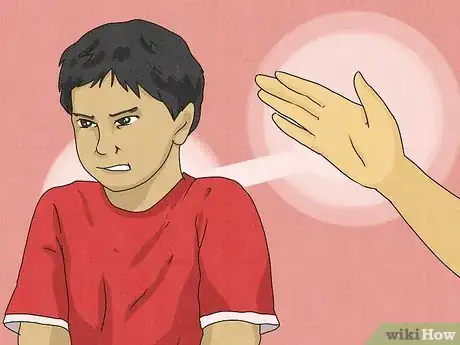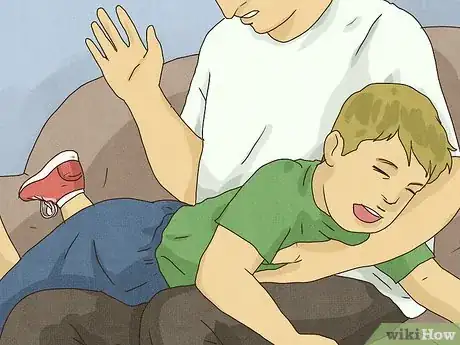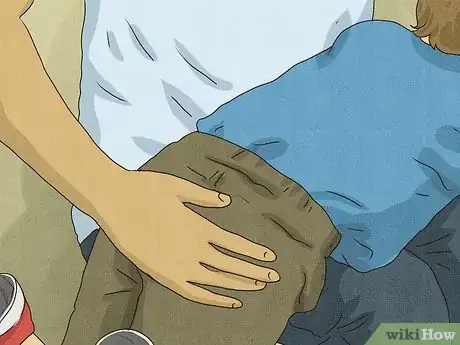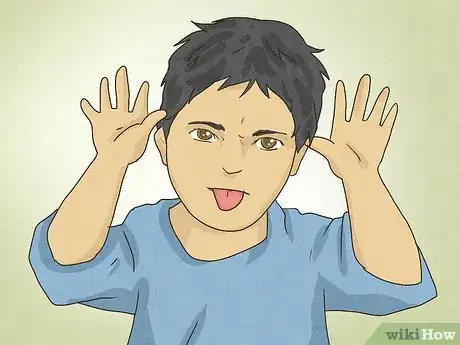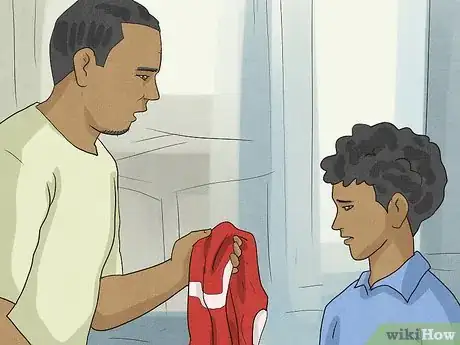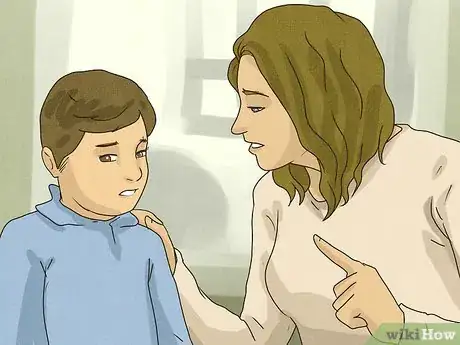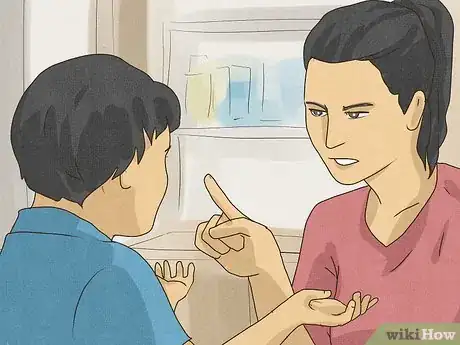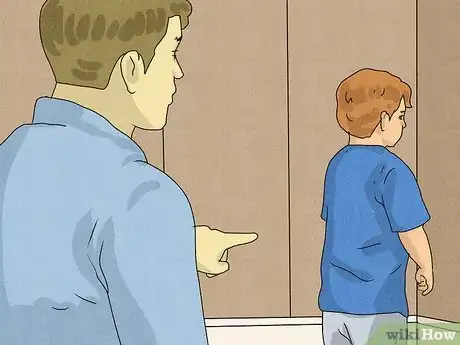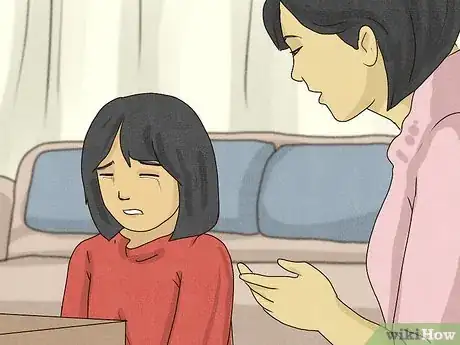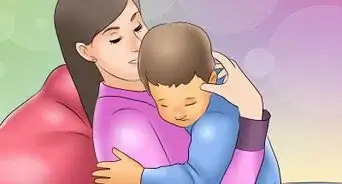This article was co-authored by Trudi Griffin, LPC, MS. Trudi Griffin is a Licensed Professional Counselor in Wisconsin specializing in Addictions and Mental Health. She provides therapy to people who struggle with addictions, mental health, and trauma in community health settings and private practice. She received her MS in Clinical Mental Health Counseling from Marquette University in 2011.
There are 14 references cited in this article, which can be found at the bottom of the page.
This article has been viewed 942,667 times.
Effective discipline is when a parent or caretaker is able to shape a child’s actions to create desirable behavior. The focus of any disciplinary action should be on creating order and promoting good moral character. Although there are many different ways to implement correction, some strategies have been proven to be more effective than others. Therefore, it’s very important to educate yourself on how to most effectively discipline your children.
Steps
Understanding the Risks
-
1Look at the laws in your country. Over 50 countries have banned the use of spanking, including spanking that is done by parents.[1] Depending on where you live, it may be illegal to spank your child, and you could face legal consequences as a result.
-
2Recognize that spanking is linked to worse behavior, not better. Over 50 years of research have shown that spanking is linked to behavioral problems escalating, alongside an increased risk of mental health issues, anti-social behaviour, and cognitive impairment later on in life.[2] [3] Thus, it's likely to do the opposite of what you were hoping for.[4]
- Children who are spanked at home are more likely to see hitting as an acceptable way to deal with conflict with their siblings and peers.[5]
Advertisement -
3Recognize that the impacts of spanking can last into adulthood. Research has noted that adults who were spanked as children have a higher risk of:[6] [7] [8] [9]
- Mental health problems
- Criminal behavior
- Impaired social skills
- Abuse of their spouses and children
- Less morality
- Shorter lifespan (early death)
-
4Recognize that spanking may harm your relationship with your child. Research shows that spanking, just like other forms of violence, harms the parent-child bond.[10]
- Your child may be less willing to ask you for advice about their problems.
- They might start sneaking around behind your back, to avoid getting caught.
- Your child might think that you don't love them.
- They might avoid your presence, even joining after-school activities or staying with friends, because they feel safer around people who don't hit them.
- Your child may become less open and affectionate around you.
- They (or someone else) may call CPS or the police if they think the child is being abused.
- They may even start to fear you.
Spanking Only as a Last Resort
-
1Find a private area. Conducting this type of discipline in a private area preserves the dignity of your child and prevents unnecessary embarrassment. The focus should be on discipline, and additional embarrassment for your child should be minimized.
- Most experts are adamant that children should never be spanked under any circumstances. Nonetheless, some parents believe that spanking is the best way to get children to adhere to rules. Whatever your position is on spanking, it is clear that spanking can have some negative consequences. Therefore, this method of discipline should be used sparingly and only to prevent your child from engaging in dangerous activities.
- Ensure that siblings and other children are not present during the spanking.
- If a spanking occurs in a public place, take your child to a private area away from onlookers.
-
2Explain to your child why they are being spanked. It is important that your child understands why they are being disciplined so that they learn what is acceptable and unacceptable behavior. Try to use all discipline, including spankings, as a teaching opportunity and not just punishment.
- Be sure to use clear age-appropriate language that your child understands when you explain the consequence.
- For example, you could say, "Donnie, you were running through the house with the scissors and almost ran into your brother. I have already given you a warning about this behavior so now it is time for a spanking."
- Whenever possible, give your a child a warning before proceeding to spank. This will allow them the opportunity to adjust his behavior to avoid the spanking.
-
3Allow younger children to lie across your lap with their bottom facing up. This position allows you to spank the child appropriately without causing injury. However, older children may stand up facing forward.
- Make sure that your child is fully clothed during spankings. Spankings on bare skin can cause bruising and other avoidable injuries.
-
4Pat your child on the backside. Be sure to use an open hand and use limited force. Pats should never leave any bruising or marks of any kind. The focus should be on teaching your child better behavior, not hurting them.
- Objects should never be used to spank your child and you should limit spankings to approximately two to three pats on the backside.
- Never spank your child when you are angry. Any spankings should be done when you are calm. This will help you avoid unintentional injury.
-
5Allow your child to return to their normal routine. When the spanking concludes your child will likely be upset. Allow them the opportunity to calm down. Let them know that when they are ready they can resume normal activity.
- For example, you could say, "I know that you are upset. When you are ready you can come back downstairs."
Establishing the Rules
-
1Decide on the family rules. Make sure that you and your spouse or any co-parents in the home are in agreement with the rules. It is very important everyone is on the same page with discipline so that your children are unable to split or divide parents and caretakers.
- You can include your children in making some of the rules. It’s important that children feel like they are a part of family decisions. However, don’t be afraid to be firm about the important issues. For example, if your teenager needs to be home by 11 pm don’t allow them to argue their way into a 2 am curfew.
- It is important to communicate your expectations regarding your child’s behavior with relatives, babysitters, and other caregivers outside of the home. If the caregiver is unable or unwilling to adhere to your behavioral expectations with your child, then you should consider putting your child in the care of someone whose parenting beliefs better align with yours.
-
2Explain the rules to your children. After a rule is finalized, it’s very important to be clear about the expectations so that rules are clearly understood. Make sure that the rules are explained when your children are calm and be sure to use language that they can easily understand. Trying to explain your expectations when your child is upset or tired will not really be helpful. You should be calm and well-rested when having this discussion as well.
- Make sure that the rules are concrete and specific so that there is no room for misinterpretation. For example, it’s better to tell your ten-year-old, “Be home by 7 pm” instead of “Be home before it gets dark.”
- Make sure that the rules are explained in advance. Try not to only discuss rules after one is broken. Instead, explain them in advance, even if it means repeating yourself. For instance, you could say, “We walk when we are at the pool” before arriving at the pool.
- Try to word rules in an affirmative manner. For instance, you would want to say, “We walk when we are at the pool” rather than “Don’t run while at the pool.”
-
3Enforce the rules consistently. Be consistent with the rules so that your children can clearly understand them. If you only enforce rules sporadically then you will confuse your children. This confusion will make it difficult for them to clearly understand your expectations and boundaries. So, if the rule is that your child is home by 7 pm then when he calls and asks if he can stay at a friend’s house later, remind them that the rule is that he is home by 7 pm.
- If there was no rule formerly in place about a particular behavior when it occurs, then it’s important to take time to establish the rule and clearly articulate it after the undesirable behavior occurs.
-
4Avoid arguments with your children about the rules. No, this does not mean to give in to their every whim. Instead, it means to avoid going getting into no-win arguments with your child. If you have made the rules clear and he is still trying to argue his way into submission, it’s okay to stop the conversation. The rule is still valid but you have removed yourself from the argument.
- For example, if your preteen is screaming, “It’s not fair, Ben gets to stay outside until 10 pm” you can just respond by saying, “I know he does.” Or maybe your teenager is still beating the drum about using the car to go out on a school night; you could say “What did I say?” or “I said no” without additional discussion.
- This approach should only be used after you’ve already explained the rules to your child and they are still trying to get their way. It minimizes the power struggle and helps to make it clear that the rule stands.
Allowing Consequences
-
1Reinforce positive behavior. Decide what behaviors you want to see more of in your child and reward that behavior. Your child is not born knowing what they should or should not do. As their parent, it’s up to you to train them and mold their behavior. Therefore, it’s essential for you to identify what behaviors you want your child to develop and reinforce them. Rewarding positive behavior with positive consequences is more effective than implementing negative consequences for misbehavior.
- Rewards for positive behavior should be consistent with the actual behavior. Verbal praise works well for most positive behavior whereas larger rewards should be reserved for more significant milestones. For example, straight As on a report card may warrant a celebratory dinner out.
- You could also use a token system to reinforce positive behavior. A token system is when your child can earn points or small tokens for appropriate behavior throughout the week. At the end of the week, they can trade in the tokens or cash in the points for a larger reward.
-
2Ignore annoying behaviors or habits that are not harmful to your child or others. Instead, respond to them when they are demonstrating the behavior that you want to see and you will see more of that. When you take away the attention from the negative behavior, they no longer have an audience. Often this process will reduce the undesirable behavior and increase desirable behavior.[11]
- For example, if you want your child to stop throwing tantrums, do not respond to them when they begin to demonstrate tantrums. Instead, wait until they are calm and is engaging in appropriate behavior before you respond to their requests.
- The tip above does not apply to meltdowns, which are caused by an unmet need rather than a denied want. If your child is having a meltdown, you should aim to solve the cause of it rather than ignore your child's distress.
- Only ignore behavior that poses no harm to your child or other people.
-
3Identify the reason for any misbehavior. There will be times when your child acts out. Most acting out behavior is normal and developmentally appropriate. If you can figure out why your child is misbehaving, then you may be able to prevent future misconduct. Keep in mind that there are generally four reasons that a child may misbehave: to feel a sense of power, because he feels inadequate, to get attention, or to get revenge.
- If your child is acting out because they feel powerless, you may give them other age-appropriate opportunities to assert power. For example, they could start having more choice about what to wear to school or what to have for breakfast.
- If your child is struggling with feelings of inadequacy, you can help them identify their strengths and allow them to participate in activities that they do well in to build confidence.
- Attention-seeking behavior can be easily remedied by giving your child plenty of attention and praise when they are engaged in appropriate behavior. If you give them a lot of attention before they act out, this will decrease negative attention-seeking outbursts.
- If your child is seeking revenge, it is important to sit down and have an age-appropriate conversation about how to better manage their anger. For example, you could say, “I know that you are upset and I’m sorry that your brother made you mad. However, it is not okay to punch anyone. Instead, please use your words and come talk to me or Dad about it.”
-
4Decide if a natural consequence is appropriate. A natural consequence is the natural result of a child’s own behavior. These consequences are purely the result of their actions and are not inflicted upon them by the parent. For example, the natural consequence that occurs when your child does not put their dirty uniform into the hamper is that their uniform is dirty on game day. If the natural consequence is appropriate, then allow your child to experience that consequence. Sometimes they are the best teachers.
- Natural consequences should only be used if the child is not in danger of being harmed. For example, you would not want to allow your toddler to touch a hot stove. The natural consequence would be that your child is burned and that is never appropriate.
- After the natural consequence occurs, be sure to have a conversation with your child about why it happened. For example, you could say "Sam, you did not put your clothes in the hamper so now your uniform is not clean for today's game."
-
5Decide on a logical consequence. If a natural consequence is not appropriate, then implementing a logical consequence is the next step. A logical consequence occurs as a result of a child’s behavior, however, a parent or caregiver imposes it. The most effective logical consequences should be related to behavior. Also, the consequence should not be overly punitive nor should it be so minor that the child is unaffected.
- Here’s a good example of a logical consequence: if you find that you keep telling your child not to lay their bike in the driveway then you could say, “Sam, when your bike is lying in the driveway, it prevents me from being able to pull into the yard after work. If I do not see it, I may accidentally run over it. The next time that I see your bike lying in the driveway, I will be putting it in the garage and you will not be able to ride on it for 2 days.” This is better than using a consequence that is unrelated to the behavior such as “You cannot watch TV for two days;” overly punitive such as “You can’t go to your friend’s house for a month;” or too minimal such as “You will have to come outside and move it when I beep the horn.”
- Always use respect and avoid being judgmental when utilizing consequences. For example, it is better to say, “I know that you are excited about going on the trip with your friend. However, your room must be clean before you go. If the room is not clean then you will not be able to go;” rather than saying “You are so sloppy and I’m not your maid. Clean this room immediately or you’re not going anywhere.”
- Allowing your child to help choose the consequence can be helpful. For example, you could say, “You were running in the house and broke the mirror. How are you going to replace it?” Or you could say “Sam, if you are going outside then you have to wear your play shoes. If you want to keep on your school shoes then you have to stay inside. The choice is up to you.”
-
6Follow through on the consequences. Do not allow your child to negotiate out of the consequence. Once the rule is broken then the established consequence should be imposed immediately. If you have given your child a choice about what consequence to utilize, he should stay within the perimeters of the choices. It is very important to follow through on any consequences that you say that you are going to impose.
Using Time Out with Preschoolers
-
1Give your preschooler a warning. If your little one is struggling to maintain self-control, as most toddlers do from time to time, start by giving them a warning.[12] Make sure that the warning is clear and spoken in a language that he is able to understand. You might want to say, “Sam, if you hit your friend again then you will take a timeout.”
-
2Guide them to the timeout area. If the inappropriate behavior continues, then guide your toddler to a timeout area. An ideal timeout area is a quiet place that is free from distractions such as television, toys, and other children[13]
- It might be helpful to have a predesignated timeout space in your home or other places that you visit frequently. This way you can avoid the added frustration of trying to figure out a good timeout spot.
- Be sure that you tell your child why he is being taken to timeout. And be sure to criticize the behavior and not the child. For example, you might say, “It is not okay to hit Alex” rather than saying “You are a bad boy for hitting Alex.”
-
3Require your child to stay in timeout for the designated time. Most experts agree that the most appropriate time-frame for time out is one minute per year of age.[14] So, your three-year-old would be in timeout for three minutes, your four-year-old would be in timeout for four minutes, etc.
- Your child may resist staying in timeout and this is completely developmentally appropriate for a preschooler. If they refuse to stay put, firmly but gently hold them down by their shoulders. You may also try placing them on your lap and securely holding them there while they remain in timeout.
- Some parents prefer to take a timeout away from their child instead of when the child is resisting. This could simply mean telling your child that you are taking a timeout from them and then staying in the same room to monitor them but not responding to them.
-
4Resume normal activity. Reintroduce your child back into a positive activity after the recommended time in timeout is complete. If they are still engaging in agitated or frustrated behavior, it may be helpful to give them additional time to cool down. Let them know that they are free to return to the other activities as soon as they stop crying or whatever behavior they are engaging in.
Warnings
- Do not use a belt, paddle, or any item other than your hand to spank a child.⧼thumbs_response⧽
- Under section 43 of Canada's criminal code, spanking is restricted, but not illegal. Attempts to repeal section 43 have failed. It was most recently upheld in 2004. It is strongly recommended in Canada to avoid(1) spanking a child under age 24 months, (2) spanking a child age 12 or older, (3) spanking with any kind of implement such as a belt, switch or paddle - regardless of the age of the child, (4) spanking children you are not the parent of, and (5) spanking "bare bottom", regardless of the age of the child.⧼thumbs_response⧽
- Most experts agree that spanking is not a very helpful discipline method.[15] In fact, there is some evidence that suggests spanking promotes even more negative behavior and hinders brain development.[16] It should be used very sparingly and only to prevent situations that would otherwise result in danger or injury for the child.⧼thumbs_response⧽
- Children who get spanked may develop osteoporosis and crippling depression, as well as an unhealthy abuse fetish.⧼thumbs_response⧽
- There are laws that control or prohibit spanking in some countries. Spanking is illegal in Albania, Austria, Benin, Brazil, Bolivia, Bulgaria, Cape Verde, Congo, Costa Rica, Croatia, Cyprus, Denmark, Estonia, Finland, Germany, Greece, Greenland, Hungary, Iceland, Israel, Kenya, Latvia, Lithuania, Liechtenstein, Luxembourg, Moldova, Netherlands, New Zealand, Norway, Peru, Poland, Portugal, the Republic of Ireland, the Republic of Moldova, Romania, San Marino, South Sudan, Spain, Sweden, Togo, Tunisia, Ukraine, Uruguay, and Venezuela.⧼thumbs_response⧽
- Rules in the UK depend on which country you are in. In Wales and Scotland, spanking is completely outlawed no matter the circumstances, while in England and Northern Ireland, it is illegal to spank a child unless it amounts to "Reasonable Punishment", which is decided based on the childs age and the force of the spank.[17]⧼thumbs_response⧽
References
- ↑ https://www.livescience.com/57373-52-countries-ban-spanking-france.html
- ↑ https://www.sciencedaily.com/releases/2017/11/171116132702.htm
- ↑ https://www.minnpost.com/second-opinion/2016/05/spanking-worsens-childrens-behavior-and-linked-long-term-harms-analysis-50-ye
- ↑ https://bigthink.com/paul-ratner/harmful-risks-of-spanking-studied
- ↑ http://www.apa.org/monitor/2012/04/spanking.aspx
- ↑ https://www.theatlantic.com/family/archive/2017/12/the-fourth-r/547583/
- ↑ https://www.ncbi.nlm.nih.gov/pmc/articles/PMC3768154/
- ↑ https://www.livestrong.com/article/213859-long-term-effects-of-physical-punishment-on-a-child/
- ↑ http://theweek.com/articles/760987/longterm-effects-corporal-punishment
- ↑ https://www.ncbi.nlm.nih.gov/pmc/articles/PMC3768154/
- ↑ http://www.webmd.com/parenting/tc/effective-parenting-and-disciplining-children-topic-overview
- ↑ http://www.mayoclinic.org/healthy-lifestyle/infant-and-toddler-health/in-depth/parenting-tips-for-toddlers/art-20044684?pg=2
- ↑ http://www.mayoclinic.org/healthy-lifestyle/infant-and-toddler-health/in-depth/parenting-tips-for-toddlers/art-20044684?pg=2
- ↑ http://www.mayoclinic.org/healthy-lifestyle/infant-and-toddler-health/in-depth/parenting-tips-for-toddlers/art-20044684?pg=2
- ↑ http://pediatrics.aappublications.org/content/101/4/723.full
- ↑ http://www.theatlantic.com/national/archive/2013/07/is-it-ever-okay-to-spank-a-child/278174/
- ↑ https://www.madeformums.com/school-and-family/smacking-children-what-are-the-laws-across-the-uk/

